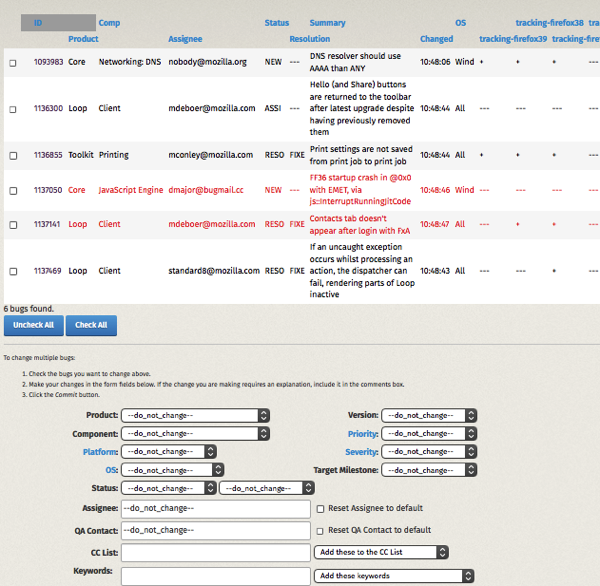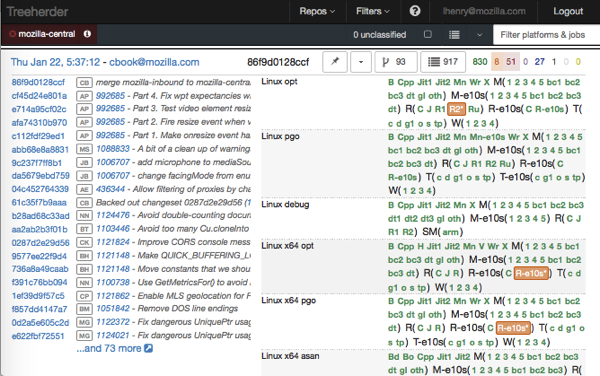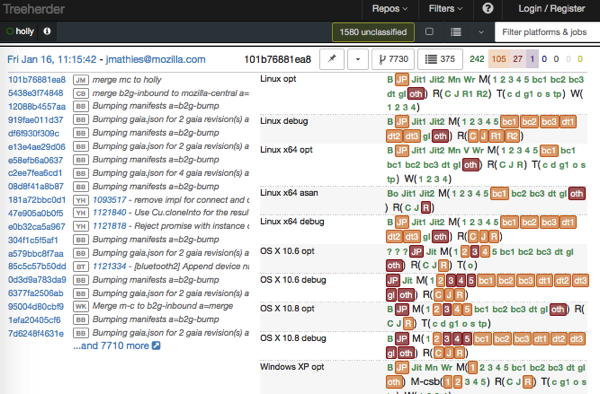My new stomping grounds are at a physical rehab swimming pool in San Francisco. It’s called Herbst Pool and it’s at the Pomeroy Recreation and Rehabilitation Center. I used to go to the Betty Wright pool in Palo Alto (that then became C.A.R. and then Abilities United). This seems quite similar. The Center was started in 1952 as a rec center for people with disabilities. It seems to have a lot of day programs, gardens, playgrounds, a gym and art classrooms, and this awesome pool where the water is kept over 90 degrees. This is the important part to me. Cold is painful on my joints and I get stiff quickly. But it also is directly painful on my “bad” leg. Regular room temperature air on my leg feels like burning ice which is why I’m a huge fan of long underwear or at least secret leg warmers (under my jeans). So, warm water RULES.
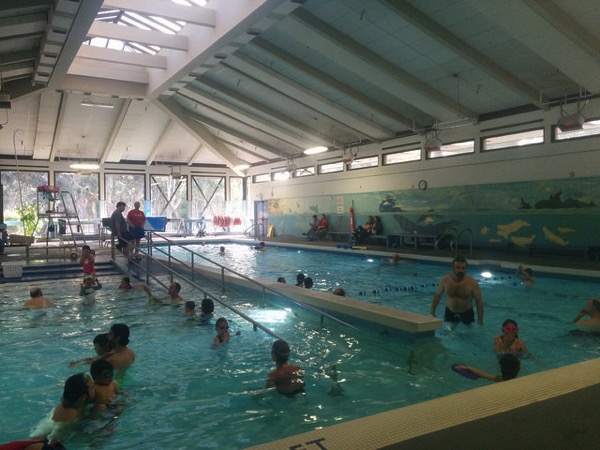
Like the Betty Wright pool, Herbst Pool or Pomeroy Pool (whatever you want to call it) has a very wide sloping ramp to enter the water, and a variety of PVC wheelchairs useful for going down the ramp. There are also very shallow and broad steps with handrails. It is easy entry into the water. They have all sorts of adaptive equipment for the water. I don’t need that stuff but I appreciate the easy entry and not having to use one of those slow, free-show lift chairs into the water. The pool is a beautiful and relaxing space as there is a skylight, and one wall is entirely windows looking out at the trees bordering Lake Merced. The walls are covered with cheerful murals of cartoon whales.
The locker room and especially the main pool room are kept pretty warm. There are many heat lamps in the pool area. Really fantastic if you can’t tolerate the cold. Of course I always wish it were warmer and had a heated floor… and a sauna…. but it’s the best I’ve ever come across.
Once I am in things are pretty good at the moment. I can walk around slowly in collarbone-deep water, and do squats and other excercises hanging onto a kickboard. When I am not in a flare up, or, in some mythical past before my ankles went awry, I am a strong and good swimmer with good endurance and a long history of loving the surf. I feel super happy in the water, light and gravity-free (as long as it is warm). I’m going every week for physical therapy in a small group that’s run through Potrero Physical Therapy (note: they are awesome.) And I am trying to fit in at least one other pool visit per week, hoping to get to 3 hours total a week.
It is hard for me to get to Pomeroy. When I was gearing up to do this I didn’t find directions on their site for how to get there by bus, and it was really unclear on Google Maps from their address (on Skyline) where the entrance was on a rather large and confusing block of land between three streets. This matters to me because it can be non-trivial for me to get from point A to point B even in my scooter (because of pain, or nasty weather) and if I do’t know exactly where entrances are and what a building or “campus” is like, I’m not going to take my manual wheelchair for sure as it can easily be too difficult for me to go it alone. So here are the details of how to get there for anyone else who is thinking of rehab at this pool.
And, while taking the hour+ long journey from my house to the pool and during the somewhat boring hour of walking back and forth I often think how I should write up a post about the pool. Here it finally is.
Getting to the pool
There is parking and drop off that is level with the pool entrance, which is on Herbst Road and up a little hill. There are at least 5 blue parking spaces and some extra. Other parking is along Herbst and you will meet that “hill” along with a possibly significant walk. From the drop off point in the closest parking lot (where paratransit will drop you) It is a pretty short walk in to the pool. I haven’t measured it or tried it yet. It is too much walk for me to do with out a chair.
There are 2 buses that go nearby, the 23 and the 18. The 18 stops on Herbst Road just outside the Rec Center campus. To get to the pool you will have to cross a non-busy street and then go up a steep slope (a full story, not something I want to do in a manual chair but might in a pinch). There is a ramp for this but again it is at least one full building story high. At the top there is a little garden with benches, and a small (not accessible) playground and grassy area for toddlers. I like eating lunch there. (I think on the other side of the campus there may be an accessible playground.)
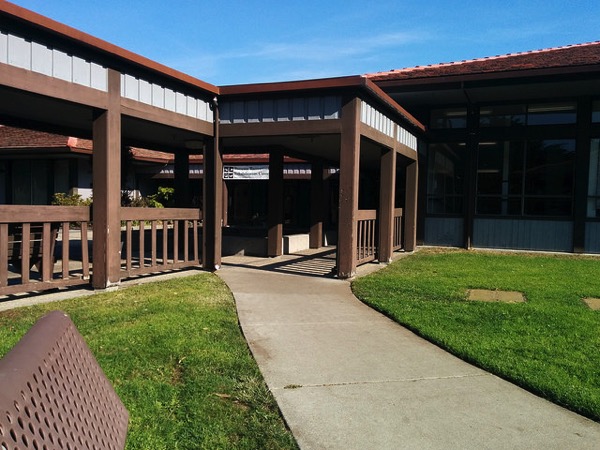
To take the 23 (the bus I ride to get there) you have to get off at Sloat and Skyline just north east of the zoo. This street crossing is a complete nightmare. It is a 6 or 8 way stop, with cars coming very fast. There are 3 medians you will need to stop on to cross another section of the road. At least it has medians! This is a crossing I would not recommend to anyone blind. Instead get off the 23 at the zoo entrance stop and cross there where there is a light and only 1 median and traffic isn’t coming from 6 unpredictable directions. This will add another 15 minutes to your journey. The Hellish Intersection scares the crap out of me every time. But I still use it because I need to get back home so I can work. The 23rd itself is a pleasant bus, not crowded, bus drivers nice and not super stressed; they are the old style buses with an unfolding ramp instead of a lift. It comes about every 20-30 minutes depending on the time and day. Note, the bus stop going inbound is not marked well and is on one of the medians in the center of the Hellish Intersection.

It is half a mile from the Sloat and Skyline bus stop to the entrance to the pool, which takes me about 10 minutes to traverse. One minor problem I have is that the sidewalk along Herbst is often littered with eucalyptus nuts and branches, so I opt for going in the street. Not a big problem as the street isn’t too busy and it’s wide enough to have room.
cost of the pool; who goes there
The pool membership costs $50 a year and you have to have a doctor fill out the application. Then, the swim sessions or exercise classes are something like $8-10 each. There is not really a “drop in” mentality but instead you are expected to sign up for a 10-pack card at the least.
This high cost, and the difficult access, may explain why I have never seen any other wheelchair users at the pool. It is weird to feel like a damn unicorn at a place specifically meant for disabled people. The physical therapy class are mostly people with injuries or recovering from surgery who have PT for a short time covered by their insurance or Medicare and the arthritis exercise class seem to be retired people trying to keep fit. The other main users of the facility seem to be disabled people who have personal care attendants, or who have developmental disabilities and are there as a sort of day camp experience doing garden work, art classes, and basketball. Lots of wheelchair users around the grounds and buildings but none at the pool at the times that I go there. I can see the community that they serve. And I am an outlier in that community and yet this place is also *exactly* what I need (integrated into my life all the time). I do wish that the pool had some sort of option for low(er) cost access, not for me, but for people in the community who are living on disability benefits who would never be able to afford this and yet who are not “in the system” enough to get bused from a group home on paratransit (as I think many of the people hanging out at the Center are).
The other swimmers I have seen are all infant and toddlers with parents bringing them for swim lessons (with no relation to anyone being disabled). It is just a nice warm pool where they have baby swim lessons, like at Petit Baleen. It is lovely and cheerful to see all the kids coming out of the pool. They always seem happy and calm and sort of stimulated. And they make me happy as I think of the nice memories of when Milo and Ada were small.
Probably the kids’ swim lessons are basically a way for middle class non disabled people to financially support the rest of the facility. (Which also takes donations.) And, I think it may also get funding from places like Target that look for a place from which to hire disabled people for low pay and some sort of tax break; whatever happens there, I hope people are paid fairly.
Extra note on Janet Pomeroy who the Center is named after. Thank you wheelchair sports camp lady!
The facilities of the pool
The building itself has automatic doors. There is a station where you can check in and pay for your session. Also two vending machines with drinks and snacks.
The women’s locker room has a big heavy door quite difficult to open. They need a push button for the doors. Inside, there is a (wet) floored room lined with benches. There are a few hooks to hang coats or bags but no lockers at all and no curtained areas for changing. It is just one big room to change in. Probably that is to fit a maximum number of people (and wheelchairs?) into the room. The outcome of this is that many people lock themselves into the three bathroom stalls so I make sure to use the bathroom outside the locker room by the gym. Aside from this minor annoyance I do feel critical of the situation as the upshot is old ladies who have had hip replacements changing into bathing suits in a slippery tiled floor bathroom stall seems like a recipe for badness. (Add in an incoming and outgoing class of non-disabled toddlers to imagine this completely.) I think they are dealing with this by building a new (unisex) changing area for wheelchair users or people with attendants, in the main area of the pool. (The Abilities United pool also has this.) One last bitch about the locker room, it has no tampon machine. Come on folks. It’s a pool bathroom. What more important place are you going to be where you will need emergency tampons?! But I digress.
There are nice showers in the locker room, one with a curtain but all the rest open. The water is hot. Yay. The locker room has a heavy difficult door to get into the pool area.
From there it is cake; there is another shower for rinsing off near the pool and there are some open cubbyholes to put your stuff in if you don’t want to leave it in the (non-lockered) locker room. I notice that getting into the pool many people have both flip flops and walking canes. Some thought to this common situation would be good and it coudl be solved with another set of cubbies and some sort of cane holder that would take twenty-eleven canes. There is always a pile of flip flops and canes right at the point where the handrail begins! Plus, my scooter unless I am confident about the walk from the shower area to the pool and back.
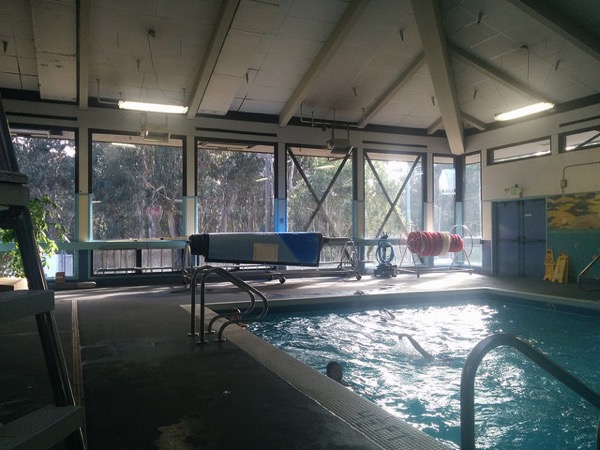
emotions and memories of physical therapy
I can’t imagine how many of the ladies in PT with me manage the trip there or even the walk from the parking lot. It is always hard to remember how that works until I get back into that territory of ablilty. Driving + hobbling. I was there for years.
I remember so many times of “rehabbing” in pools over the last 20 years. At Valley Medical Center in the 90s it was depressing and squalid and yet the warm water was so freeing. I could move freely and learned some good exercises. It was hard to talk with the other people there who were all older women while I was in my 20s with a mohawk and two septum rings. These days at least I am middle aged looking and not unacceptable as a possible conversation partner to ladies who have hip replacements.
It was always an ordeal to get to a hospital and navigate it and also inherently depressing. I have swum at YMCAs, JCCs, many city pools, and so on which I far prefer to going to hospital therapy pools. The public pools are way too cold for me to tolerate. I worked up from 15 minutes to 45 minutes in a “normal” temperature pool where athletic people swim laps, but it’s never a good experience. The SF JCC has the second warmest pool in town, plus a hot tub and a sauna, by the way, but it is extremely pricey as well as being ultra clean, pretty, and posh. The CPMC hospital has a warm pool, and you can get PT from it, so that is an option, but last I checked it was not only out of service but you couldn’t “drop in” extra at all; you have to get on a waiting list for a weekly arthritis class and if you miss two classes they boot you to the end of the waiting list. That will not work well for me. So I am very glad that places like the Pomeroy Pool and Abilities United exist.
I thought over my times at the Betty Wright Center which had really good cameraderie and where I got a lot stronger. I remember starting out at Betty Wright crying uncontrollably and feeling that I could not take it but grimly slogging through. That always happens both physically and emotionally. In fact at Pomeroy I know we all cry in there sometimes. Even if not from pain, it is because it is easy to go about our lives somewhat disconnected from our bodies. Being in the water and having nothing else to do but gently move around, it can be an emotional experience. I am thinking directly about what I can and can’t do, and comparing it with other times in the water, often ones where I was hitting rock bottom physically. I notice consistently my problem is not, “not trying hard enough” it is pushing myself way too hard and re-injuring myself or making everything worse. This is the new era of caution for me. Some of this holding back is possible because of working with a behavioral therapist who is very knowledgeable about pain, disability, and chronic illness. Thanks Dr. C.
(There is also the aspect that doing this 3.5 hour journey means I have to put on a lot of psychic armor to deal with strangers, bus drivers, buses with broken lifts, the Hellish Intersection, people cursing at me for being in the way, people staring, people (nicely or otherwise) inquiring about my scooter or wheelchair, people angry with me for not accepting their “help” properly, and all the other things that make leaving the house an Epic Journey. I armor up and am prepared for it all but it is not without emotional effort and cost. It is never simple. For me to get anywhere, I have gone through this process already and have likely had many challenges to basic equanimity.)
Last fall I could not go into the water without soft ankle braces. It hurt too much to have the tiny currents of the water, wiggling my ankles around unpredictably. Right now I can do a lot of squats and toe-raises and walk back and forth for the whole hour. It’s great. I am not swimming yet as my knees and ankles (and i think back) aren’t strengthened enough. I cannot do things I used to be able to do in pool rehab, like write the alphabet with my foot in cursive. Nope nope nope nope nope nope! But, I have improved my gait (again) to be more even and to weight shift instead of limping or shuffling.
My goal right now is to get my ankles strong enough that I can drive to the pool, park there, and use my manual chair. That would be less physically grueling for me than the 2 hours of bus ride and scootering. It usually takes 3 and a half hours out of my day to get there by bus. By driving, I could be gone from work 2 hours instead. That means I could swim more often. My real goal though is simply to maintain this level of water-walking and aerobic exercise for health, flexibility, and strength without injuring myself. This is already the longest stretch of time I have consistently made it to PT or exercise without messing myself up, and also doing daily PT at home. Huzzah!
A last note, huge props to Pomeroy staff for letting me use a conference room in their office one day last fall as I wanted to be at a crucial team meeting but didn’t want to skip my PT appointment. They let me walk in out of the blue and use their office and their wifi and close the door for privacy. Super nice of them. I was able to give one of their staff all the details about TravelScoots and other lightweight scooters in return. I still feel I owe them some free computer advice or help! But, I thanked them for supporting a person “in the community” (me) in their job and also for helping make Firefox better (ha!) by getting me to my meeting on time!


